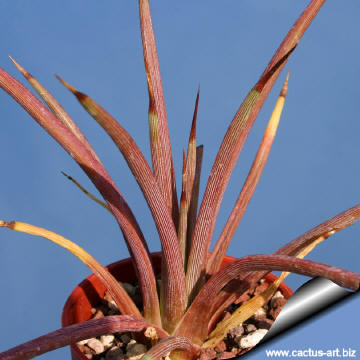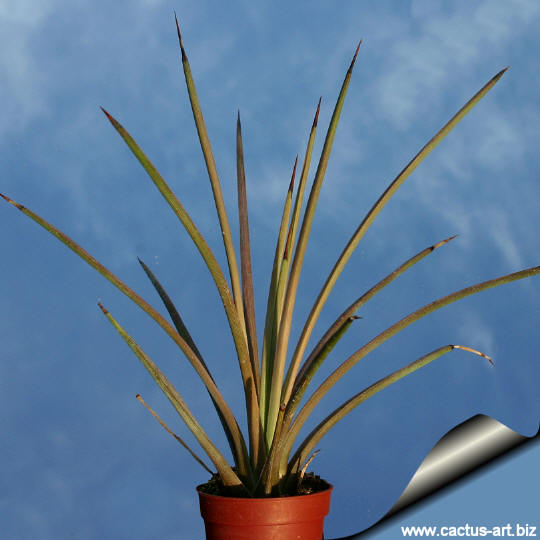|
|
|

Agave stricta (A young specimen)
A mid-sized Agave that forms perfectly spherical rosettes up to
80 cm in diameter, that consist of countless hard, narrow leaves with a
pronounced terminal spike.
|
|
Description: It is a small species, forming
large balls of skewer-like leaves and looking like a very nasty
porcupine. This species has the tightest spherical shape of any agave
and will form offshoots to create a colony of rosettes. Each rosette
grows in a slightly different direction and reminds one of a freeze-frame photo
of grasses blowing in the wind or of forests of anemones moving with the
currents.
Stem: Thick branched.
Rosettes: Individual rosettes, with hundreds of thin leaves, 30 to
100 cm in height and width.
Leaves: Narrow, evergreen, yellow-green, green or glaucous blue,
square to roundish in cross-section , toothless on the margin, about 35
cm long; thick at base, then narrowing to end in a very sharp spine.
The forma rubra (red form) has thin red longitudinal lines
on the leaves that give it a red colour that enhances under stress
condition (especially drought, strong sun and cold)
Flowers: The flowers vary from green to reddish brown or purple,
on a dense150-200 cm spike-like raceme. It is one of the few
non-monocarpic Agaves (just like
A striata)
Blooming season: July to september. May flowers when mature at
8-10 years.
NOTE: It is very similar to Agave striata, but tends to
have more and somewhat curved leaves, shorter flower tubes and a
generally more symmetrical shape. In addition the leaves have a rounder
section. A mature plant of Agave sticta looks like a meatball or
a balled-up hedgehog. Once you have seen this plant, you won't confuse
it with the similar looking and sounding Agave striata.
|

Agave stricta nana "Blue form" |

A. stricta forma rubra |
|
Advertising
|
|
|
|
|
Family: Agavaceae
Scientific name: Agave
stricta Salm-Dyck
In: Bonplandia 7(7): 94 (-95). 1859
Origin: Agave stricta is native to the Tehuacan
Valley of southern Puebla and northern Oaxaca, in Mexico.
Habitat: It is generally found on dry hills and on flats in
the open desert.
Ecology: It is one of the few non-monocarpic
agaves. The initial rosettes,
after the flower stalks finish blooming in
mid-summer, branch and continue to grow, eventually creating a stack of
porcupine-like balls.
Conservation status: Listed in
CITES appendix 2.
Common Names include: Needle Agave, Needle Leaf
Agave, Globe Agave, Hedgehog Agave.
Etymology:
Synonyms:
- Agave striata var echinoides (Jacobi) Baker
- Agave striata var. stricta (Salm-Dyck) Baker (1877)
|
|
|
|

Cultivation: A.
stricta is a versatile and very hardy plant that can be grown in
half-shade to full-sun. It can take moderate to severe freezes,
and is extremely drought tolerant. In winter watering
this plant can be done once every 1-2 months, there is no need to mist
the leaves. Agave stricta is theoretically hardy to -4° C,
particularly when dry - but
it is best to avoid severe
freezing temperatures. Heat Tolerance: Excellent
Propagation: Relatively
easy to propagate by
suckers (if available) Remove the basal suckers in spring or
summer, and let the cuttings dry for a few days before inserting in
compost.
Photo of conspecific taxa, varieties, forms and cultivars of
Agave stricta.

 |
|